| EXHIBITIONS NEWS PRESS ABOUT US CONTACT |
|||||
| REPRESENTED ARTISTS | BERTILLE BAK | GWENAEL BELANGER | DEXTER DYMOKE | ANTTI LAITINEN | |
| MARKO MAETAMM | YUDI NOOR | OLIVER PIETSCH | KIM RUGG | ||
| BETTINA SAMSON | SINTA WERNER | ||||
GORDON
CHEUNG
ROSIE LEVENTON
BRIGHID LOWE
EMMA MCNALLY
ABIGAIL REYNOLDS
TOVE STORCH
SARAH WOODFINE
UNFOLD
26 June– 2 August 2009
The connotations associated with paper refer systematically to the idea of retranscription; writtings and drawings being the retranscription of voices and thoughts and more widely of a certain reality. Through a range of differents practices and investigative approaches, Unfold questions a creative and explorative process which has the particularity of stepping, conceptually or concretely, from two dimensional mediums into a three dimensional space. These “new types of spatial fields” consecutively play and emphasize the virtual aspect of the “drawing process”, the physical nature of its material (carbon, paper) and techniques often associated to paper such as cutting, collage, folding; and therefore focusing on an interest in the physical world surrounding us.
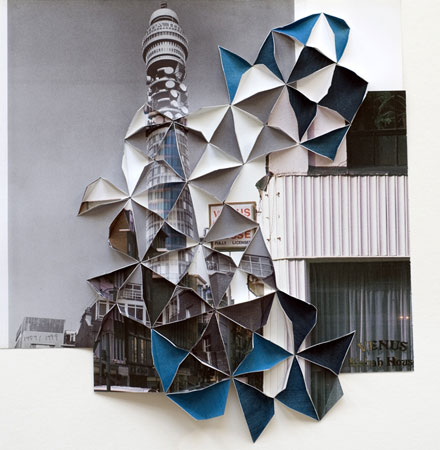
Abigail Reynolds works with
trajectories, networks and ordering systems. As a starting point she
sets in motion a system and set of processes that result in a form being
created. She works with materials to bring fugitive knowledge and connections
into the immediacy of physical experience.
The series of collages “The Universal Now” plays with the
idea of puzzle-like quality of something being thought-through. Splicing
and joining images issued from second hand tourist guides, atlases and
other photographs of the last century, Reynolds then cuts the paper
in order to be able to fold it; pushing upwards and outwards. These
new three dimensional objects go on to play with the viewer’s
perception due to the perspective created by the grid and the changing
and moving of the construction. (Abigail Reynolds is represented by
Seventeen gallery).
Brighid Lowe
uses a wide range of situations, materials and scale from site-specific
installations to small, single photographs through which a new reading
is encouraged. Central to Lowe's work is the idea of montage or assemblage,
in which a juxtaposition of elements disrupts the context in which it
is inserted. Recent work has also included the use of text, in various
formats, collected from our daily surrounding.
The artist’s interest in the intersection of the virtual and the
material is developed through a series of ongoing works called “Rain
Drawings”. Using rain to interrupt a repetitive surface, the
artist explains that the intention of this series is to set a concrete
space against other imagined spaces or systems. In the drawing, repeated
horizon lines are hand drawn onto the paper, which is then exposed
to rainfall - the original linear marks then record the material, yet
retaining the romantic space of the rain.
Emma McNally
investigates the possibilities of semiotic connections and disconnections
through a visually and conceptually dense use of pencil on paper. Her
large and small-scale drawings offer themselves to the viewer as surfaces
or sites for rhythmic relations of graphite marks disruptively connected
in gatherings, collisions, swirls and dispersals that are both geometric
and chaotic.
Her drawings lead us into worlds whose ramifications and layered works
recall different essences of reality from the micro cosmos to the macro
cosmos; her work also suggesting aerial views, geological formations,
oceanic charts, disease transmissions, animal migratory routes as molecule
structures and black holes. (1)
Gordon Cheung’s psychedelic-coloured paintings reveal an apocalyptic vision of our globalized world. Through a mixed medium of spray paint, oil, acrylic, pastels, newspaper and ink, Cheung is interested in the way we move between the physical world and the virtual realities of communications, technology, global finance and the internet. Cheung depicts artificial spaces, including epic landscapes informed by imagery such as science-fiction and 19th century romantic painting. “I use the Financial Times newspaper stock listings as I think of the stock market as a global dream-world that literally flows through all of us. This for me is a contemporary form of landscape from where I take inspiration and fuse images from the Internet on computer before printing directly onto sections of the stock listings to jigsaw back together on canvas.“ (2)
Rosie Leventon
makes indoor and outdoor sculptural installations using a broad variety
of recycled materials. All of Leventon's work however is grounded in
a sensitive concern for the natural environment and how we use it. She
sees her work as a way of interweaving a kind of personal archaeology
with the archaeology of contemporary society and the physical archaeology
of places, incorporating elements of surprise and humour.
Made with Paperbacks, the tower refers to suburban social housing -
symbolising a space where large numbers of people gather without however
being able to see, from an outside observation, any traces of life other
than small spots of light.
Sarah Woodfine trained as a sculptor, which is evident in her approach to landscape, architecture and optical illusion - all being recurring themes in her work. Her drawings are often constructed as self-contained three-dimensional worlds reminiscent of architectural models and of children’s toys such as cut-out card castles and toy theatres. Each element is drawn in pencil with a precision and clarity that suggest a perfectly observed reality, but also conjure up the obsessive hallucinatory character of a dream or fantasy. Accessible and intimate, these scenes are made up of fragments and clues which invite viewers to invent their own stories.
Tove Storch combines virtual and physical aspects of the world in order to create objects which belong to a third kind of spatiality. She examines sculptural presence and spatial experience by asking questions such as : How does a form, volume or shape appear? - What are the formal rules for creating a sculpture? Storch’s sculptures are static while deeply engaged with movement. She investigates how sound or movement would look physically. Fragility and transience are found in all of her attempts to make three dimensional objects. The works are at once concrete, physical and real but at the same time transparent, floating, absurd and imaginary.
(1) See Ana Balona de Oliveira Fields, Charts, Soundings (Essay), January
2008
(2) Interview of Gordon Cheung in MYARTSPACE>BLOG / http://www.myartspace.com/blog/2007/11/art-space-talk-gordon-cheung.html,
Nov 07
Abigail Reynolds lives
and works in London, UK. Solo shows: The Universal Now, Seventeen
Gallery, London (2009); ShapeShift: Landscape in motion, Durlston
castle, Dorset, UK (2007) / Group shows: Embedded, Gimpel Fils Gallery,
London, UK (2008); Tatton Park Biennial, Parabola, UK (2008); Jardin
d’acclimation,
Villa Arson, Nice, France (2008); From a Distance, Wallspace, New
York (curated by Vincent Honore) (2007); The Islanders, Nettie
Horn, London (2007); NEVERODDOREVEN, Serpentine Gallery, London
(2007); Behemoth, Danielle Arnaud Gallery, London (2007); Day to
Day Data, Danielle Arnaud London (2006)
Brighid Lowe lives and works in London, UK. Solo shows: Jerwood Artists
Platform, Jerwood Space, London (2004); Archives de la Critique d'art
commission for symposium and publication, France (2001); Unedited Confessions,
Galerie Vox, Montreal, Canada (2001) / Group shows: Embedded, Gimpel Fils
gallery, London, UK(2008);Jerwood Drawing Prize 2007, Jerwood Space, London,
then touring (2007-08); Paulo Post Futurum, Lokaal 01/Breda’s Museum, Breda, Holland (2007); Tonight, Studio
Voltaire, London (2004); New Religious Art 1992 – 2002, Liverpool
Biennial, Liverpool and Henry Peacock Gallery, London (2002); Intelligence:
New British Art 2000, Tate Britain, London (2000)
Rosie Leventon lives and works in London, UK. Exhibitions and commissions:
Concrete and Glass, Shoreditch Town Hall, London (2008); Et Pendant
ce Temps..., NETTIE HORN, London (2008); Parallax, Fieldgate Gallery,
London (2008); Eyestorm (opp. Tate Modern), (2007); Queens House,
National Maritime Museum, Greenwich; Undercurrent, Fabrica, Brighton
(2007); International Glass Biennale, Ruskin Glass Centre, Stourbridge
(2004); Royal Society of British Sculptors (2000-2001); Commission
for the garden of Mrs Anne Wood CBE, Atrium Gallery, Price Waterhouse
Coopers, London (2001)
Emma Mcnally lives and
works in London, UK. Solo shows: Fields, Charts, Soundings, T1+2
Gallery, London (2008) / Group shows: Avatar of Sacred Discontent,
9 Hillgate, T1+2 Gallery/ Flora Fairbairn Projects, London (2007);
Cannibal Ferox, T1+2/ Paradise Row, London, UK (2006); The Constant
of Variation 2, T1+2 Gallery, London (2001); The n°8 Bus, T1+2
Gallery, London (2001)
Gordon Cheung lives and works in London, UK. Solo shows: The Promised
Land, Jack Shainman Gallery, New York USA (2009); TECHNOPHOBIA, Harris
Museum, Preston UK (2008); Wilderness of Mirrors, Galerie Adler,
Frankfurt, Germany (2008); God is on Our Side, Unosunove Gallery,
Rome Italy (cat) (2007); Heart of Darkness, Thomas Cohn Gallery,
Sao Paulo, Brazil (2006) / Group shows: The Future Can Wait, Truman
Brewery - Ellis Rumley Projects, London (2008); PS: Parsing Spirituality
Affirmation Arts, New York City, USA (2008); Currents: Recent Acquisitions,
Hirshhorn Museum & Sculpture Garden, Washington USA (2007); Fash
n Riot, Photographer's Gallery, London
Sarah Woodfine lives and works in London, UK.
Solo shows: Ha Gamle Prestegard, Norway (2007);
The Drawn Curtain, Danielle Arnaud contemporary art, London (2006);
Dorman Museum Middlesbrough, UK (2003); Five Years, Danielle Arnaud
contemporary art, London (2000)/ Group shows: The Beguiling ... ,
Bury St Edmunds Gallery (2008); isobar, Fieldgate Gallery (2007);
Snowdomes, National Glass Centre, Sunderland, UK (2006); Cloud &
Vision, Museum of Garden History, London (2005); Staged, Danielle
Arnaud contemporary art, London (2005); The Jerwood Drawing Prize
(2004)
Tove Storch lives and works in Copenhagen (Denmark) and Vienna (Austria).
Solo shows: The Weakest Link, Stedefreund, Berlin; KBH Kunsthal,
Krabbesholm Højskole, Copenhagen, Denmark (2008); Overgaden - Institut
for Samtidskunst, Copenhagen, Denmark (2008); Gallery Kirkhoff, Copenhagen,
Denmark (2007); Superhorst, offspace Berlin, Germany (2006) / Group
shows: Et Vintereventyr, Gl. Holtegaard, Holte, Denmark (2009); The
Weakest Link, Stedefreund, Berlin, Germany (2008); Reduced, Karma
International, Zürich, Switzerland (2008); Pimp my walls, Stefan
Schuster, Strelitzerstraße 59, Berlin, Germany (2007); The Lab,
INTO POSITION, Bauernmarkt 1, Vienna, Austria. Curated by Severin
Dünser (2007)
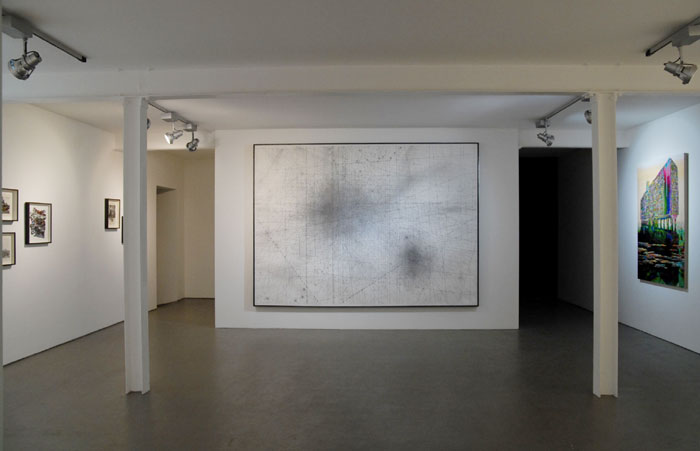
Installation View, Unfold, NETTIE HORN, London
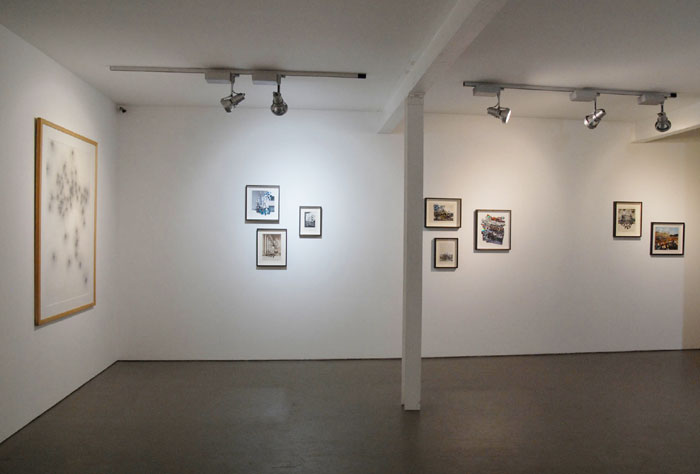
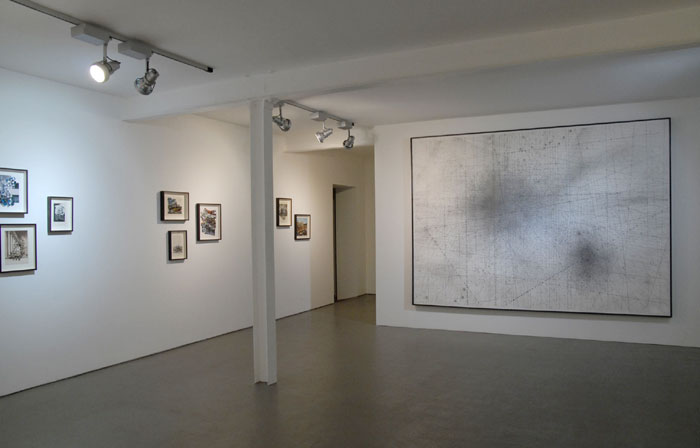
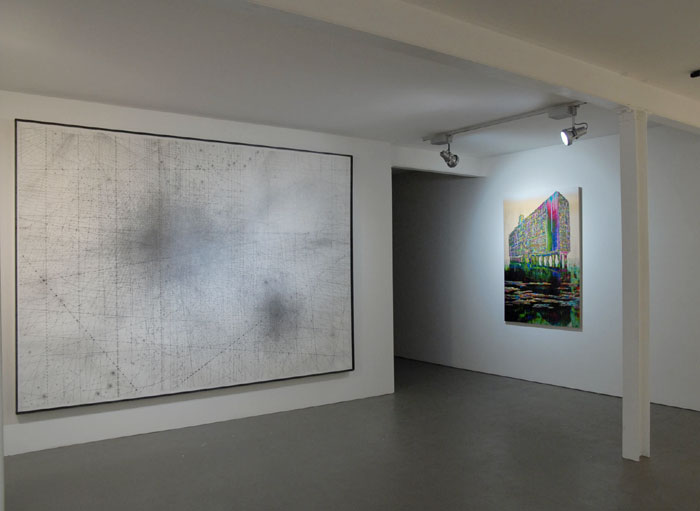
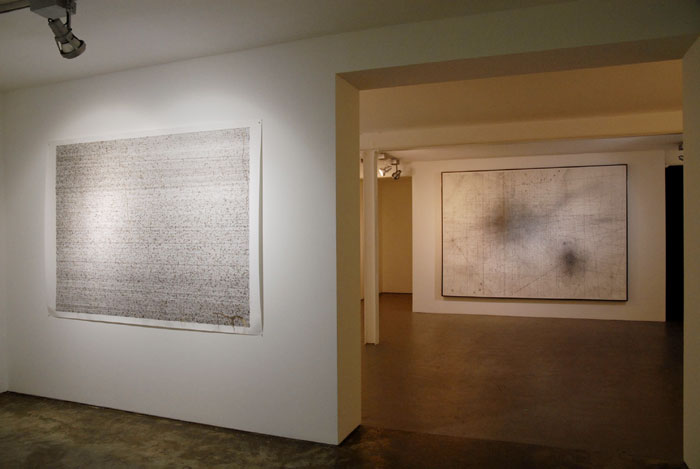
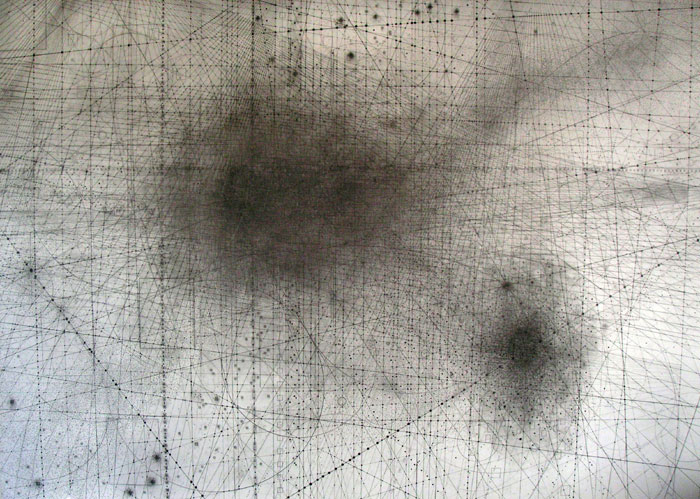
Emma MCNALLY
Field 6
2009
305 x 221 cm
Graphite on paper 2009
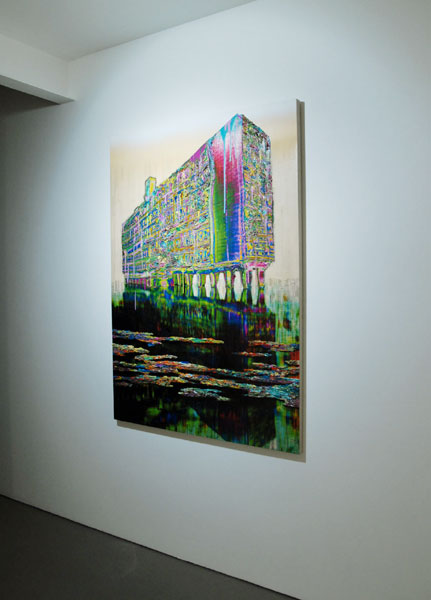
Gordon CHEUNG
Living Machine (Study)
2008
109 x 154 cm
stock listings, ink, acrylic gel and spray on lascaux cloth
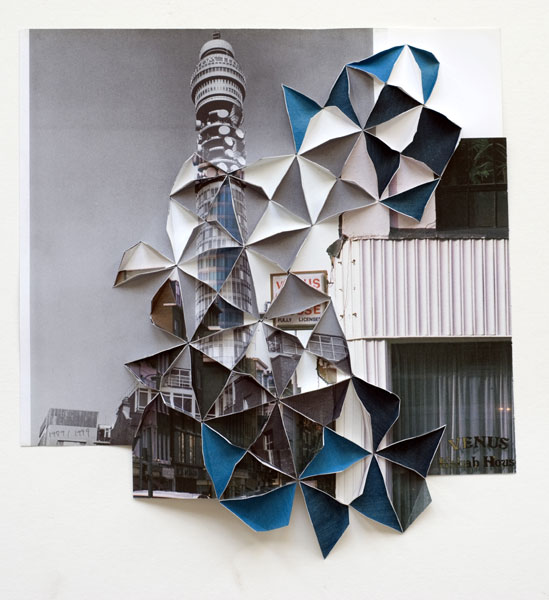
Abigail REYNOLDS
Post Office Tower 1989/1999
2009
Cut and folded vintage bookplates
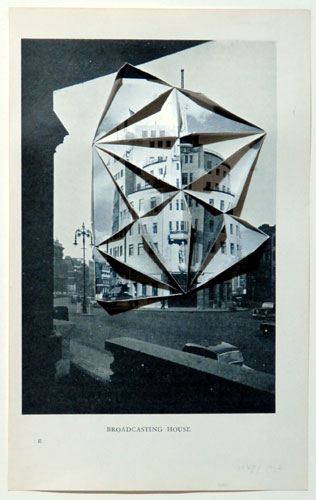
Abigail REYNOLDS
Broadcasting House 1948/1967
2008
Cut and folded bookplates
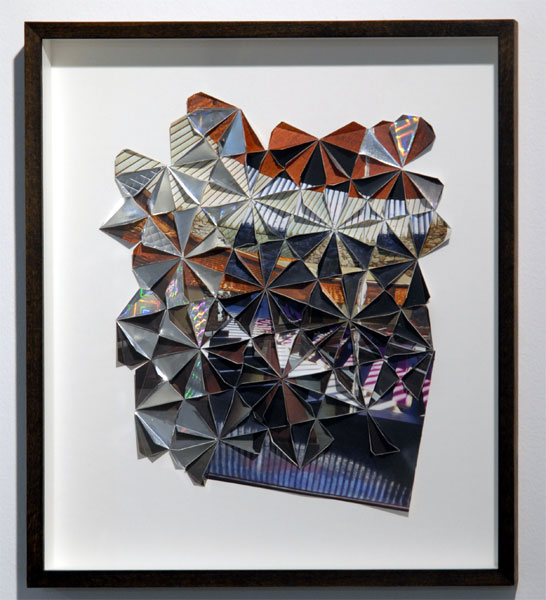
Abigail REYNOLDS
Rock Church Toolo 1998/1974
2006
Cut and folded vintage bookplates
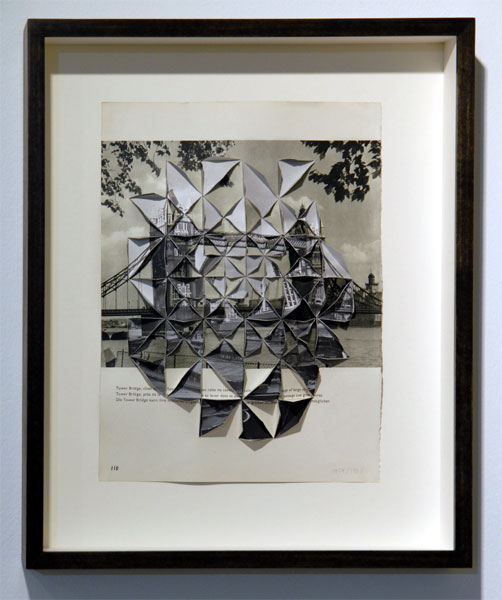
Abigail REYNOLDS
Tower Bridge 1959/1965
2009
Cut and folded vintage bookplates
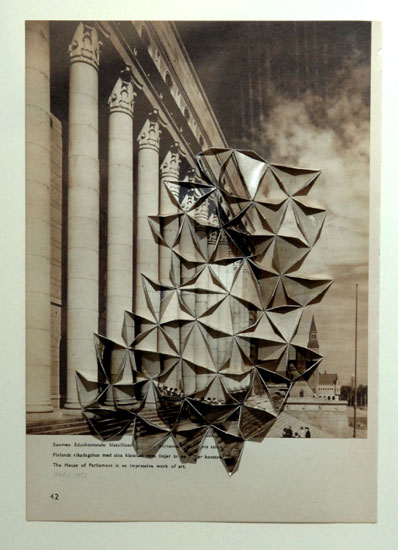
Abigail REYNOLDS
Houses of Parliament Helsinki
1948/1952
2007
Cut and folded vintage bookplates
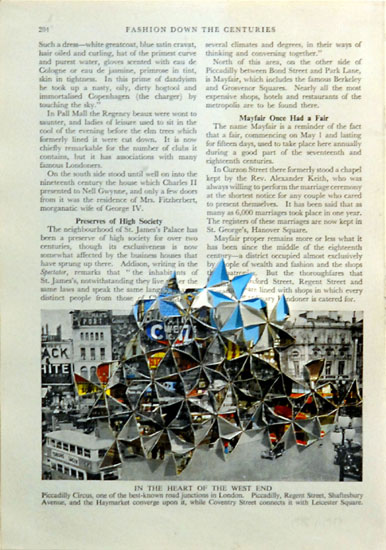
Abigail REYNOLDS
Piccadilly 1938/1984
2009
Cut and folded vintage bookplates
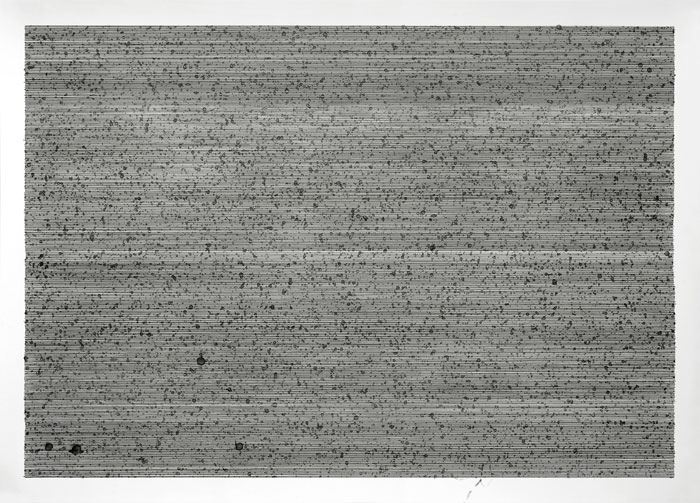
Brighid LOWE
Rain Drawing I
2006
Pen, paper, rain
150 x 213 cm
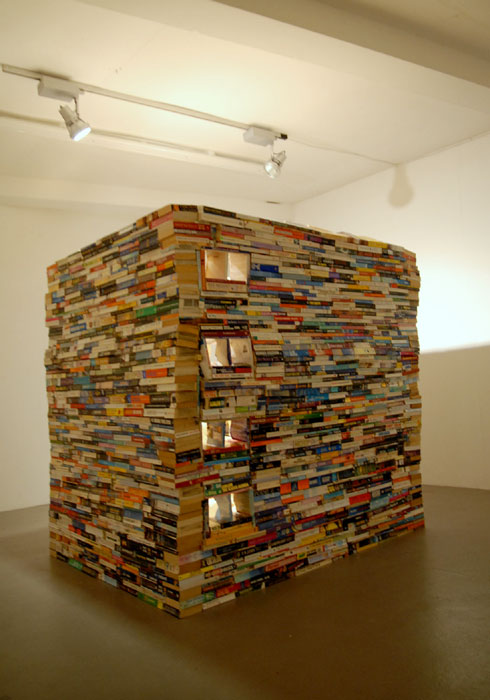
Rosie LEVENTON
Somewhere a door slammed…
2009
Around 2000 books
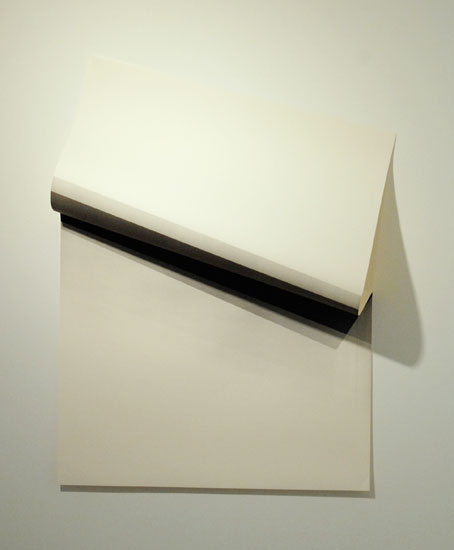
Tove STORCH
UT
2007
Silk screen / 120 x 80 cm

Tove STORCH
Skyggebillede (Shadow Picture)
2007
Silk screen / 120 x 80 cm
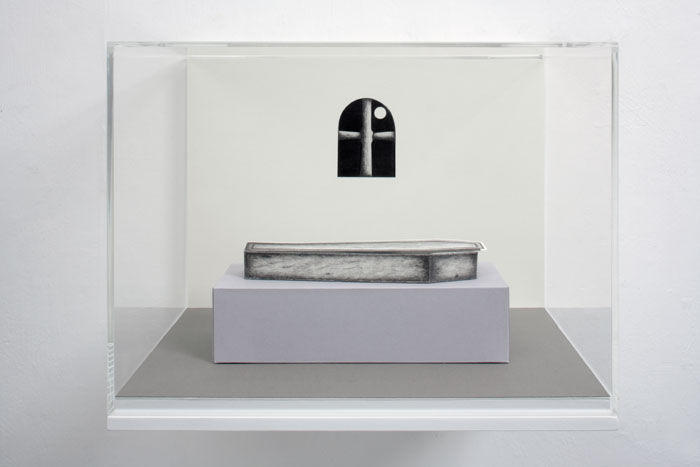
Sarah WOODFINE
Crypt
2007
Pencil on paper in perspex box
22 x 30 x 22 cm
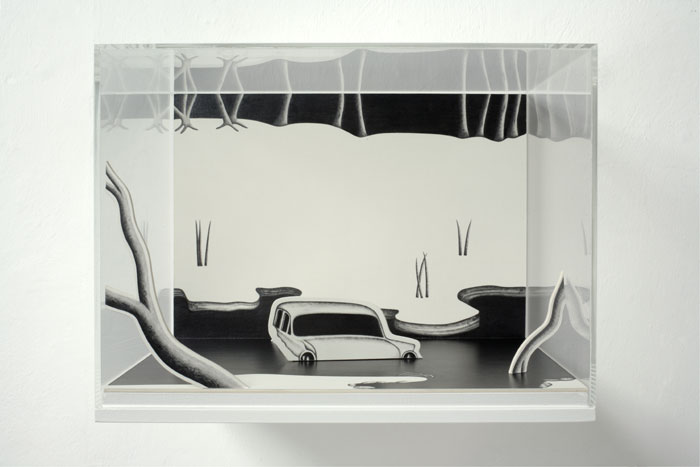
Sarah WOODFINE
Alfred's Story 2
2006
Pencil on paper in perspex box,
22 x 30 x 22 cm
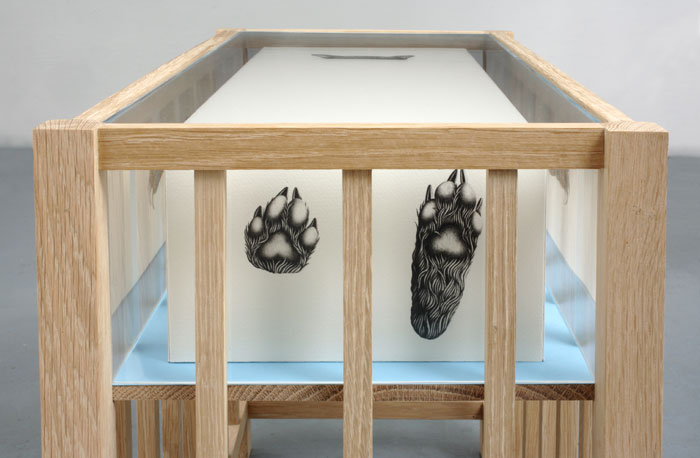
Sarah WOODFINE
Boy
2008
Pencil on paper, perspex , white oak
45 x 60 x 30 cm
© NETTIE HORN